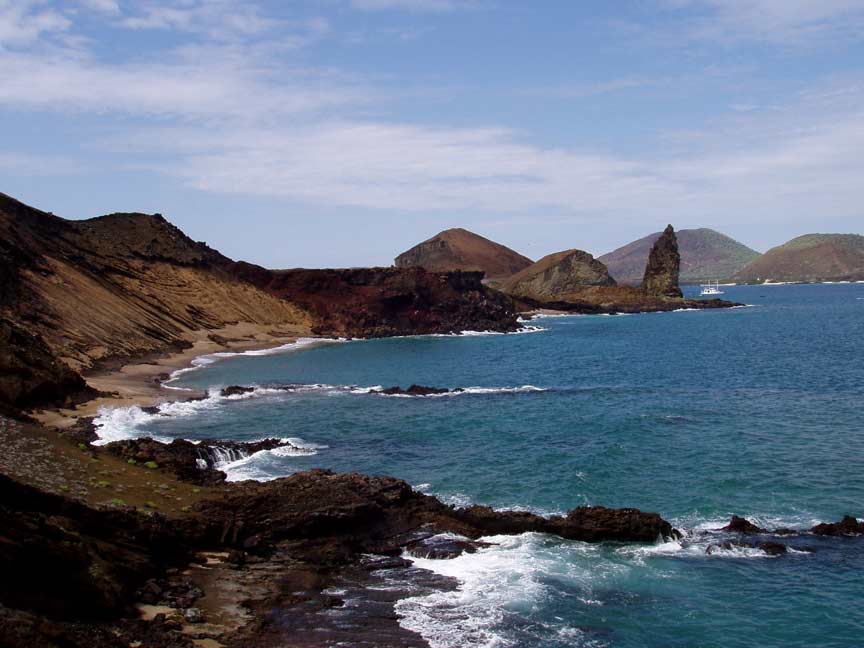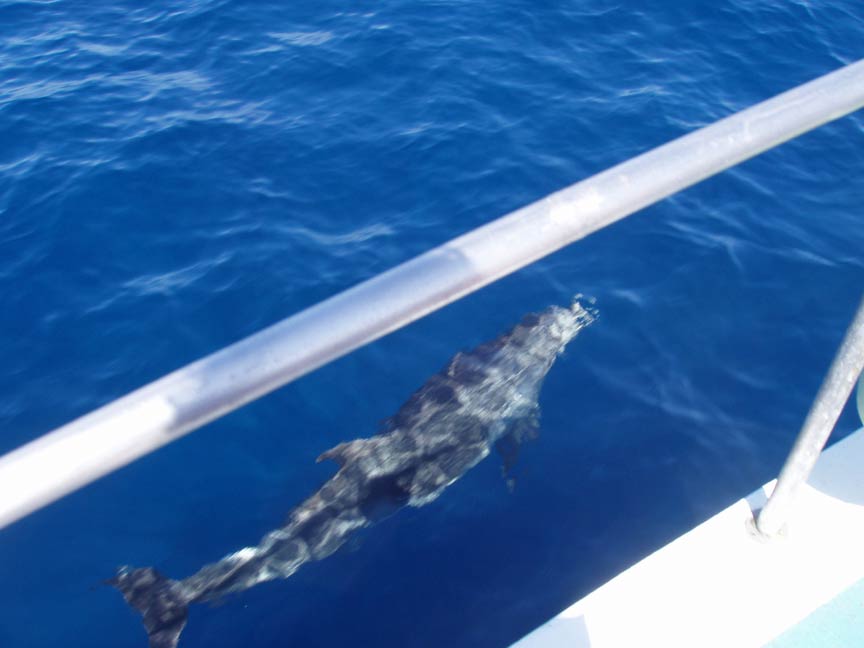Galapagos - Bartolome Island Tour

Harmonie
Don and Anne Myers
Sat 8 Mar 2008 23:07
|
00:44.827S 90:18.414W
On Saturday (2/1) we motorsailed as planned from
San Cristobal Island to Santa Cruz Island, and anchored in a cozy
fashion with about eighty other sailboats in Academy Bay near the town of
Puerto Ayora. When we first arrived, there was another round-the-world
sailboat rally here with about 30 boats. This was the 'Blue Water
Rally'. They have since moved on to the Marquesas where we will
probably run into some of them again (not literally, of course).
Here in Puerto Ayora Oscar left us and joined some
family members that just happened to be in the Galapagos at the same time.
All we have left of Oscar now are a few pictures, a pair of socks, some soy meat
(yum!) and good memories from our five day motorslog together. We wish
Oscar well and hope that he finds the perfect wave, and captures a picture of
himself underwater with a hammerhead shark (these are the two things he was most
excited about doing).
On Sunday, we went on the first of three day
tours. Most of the Galapagos is part of an Ecuadorian national park, which
means most areas are restricted, and privately owned sailboats are not
allowed to simply hop from one island to another (or even from one bay to
another) without a special permit and a local guide on board at all
times - all at a very hefty cost. So, most boaters like us opt
to anchor in one of the three designated harbors and take day
trips to the other islands via a tour boat. Our first trip was
to Bartolome, which is a very small island north of Santa Cruz.
The trip to Bartolome was fairly long, so we
left our boat at 4:45am, boarded a water taxi which brought us to land where
we boarded a tour bus which brought us to another harbor on the north side
of Santa Cruz, where we boarded a large dinghy which took us to the tour
boat. Sixteen of us World ARC boaters crammed onto the tour boat,
which was fairly modest in size and had a diesel engine. It
looked very well used and tended to list noticeably to the port side if too many
of us happened to station ourselves on that side. We spent a little
time wondering where the life jackets were and then decided the seat cushions
would do nicely as floatation devices in the unlikely event of a sinking.
The ride to Bartolome took about three hours at a whopping speed of 7.5
knots. The trip wasn't bad, but it did remind us all of our
recent motorslog from the Ecuador mainland to the Galapagos.
The tour boat crew fed us breakfast and we arrived
at Bartolome, where we were transferred to a large dinghy, which took us
to shore where we had a rather exciting moment trying to time our hop
from the dinghy onto the crumbling concrete stairs in between wave
crashes. We all made it and even the camera stayed dry, so a
successful semi-crash landing it was. In the brochures, the island of
Bartolome is compared to a moonscape. I think the words were
something like, 'When on Bartolome, you often wonder whether you have
arrived on the moon, or whether you are truly on a Pacific Island just south of
the equator.' That comparison is perfectly
fitting. Bartolome is just like being on the moon. Not
that we've ever been on the moon of course, but we've certainly seen the TV
footage of the first moon landing ten thousand times and feel we can use that
as a frame of reference. According to our guide, Bartolome has
twenty-seven volcanoes on it (none active). We hiked to the top of
one of them and aside from some very hearty small scrubby bushes, there was
no vegetation. The surface was brown and black rock and ash with lava
chunks everywhere and the molten lava tracks still visible down the sides
of the volcano. Picture 1 will give you a sense of the terrain close
up, whereas pictures 2 and 3 show the barren terrain with a backdrop of the
beautiful aquamarine bay.
Note the really big sailboat at anchor in
picture 3. Obviously they could afford the hefty fee for the personal
guide so that they could take their own boat around to all the islands.
Our guide insisted that it is the Americans that have all the money,
but we pointed out the British flag on the very large sailboat in the bay.
No response from our guide, instead he broke into song (a habit of
his) - some kind of strange Spanish/English mix that made
it impossible to tell what song he was actually singing. This strange
Spanish/English mix, or Spanglish, was the same language he used when guiding us
around the island. As a result, we only learned a few things.
For example, there are snakes that hang out in the crevices between the rocks
and under the boardwalk we were walking on (ugh) and they eat the
smaller iguanas. After eating the iguanas, the snakes upchuck (my
word, not his - he just made the motion of vomiting to get his point
across) the iguana skeleton because they can't digest it. Don
and I have no idea if this particular Galapagos factoid is true, it's
just all we could piece together from the Spanglish. The other
boaters in our group, especially those that speak English as a second language,
looked around at each other and shrugged their shoulders when the guide was
rapidly and very enthusiastically spouting Spanglish.
We finished our tour of the volcano and completed
the reverse of our semi-crash landing back into the dinghy, which took us back
to the boat. Next was snorkeling. As you might know from previous blog
entries, I am no snorkeling expert and am still working on overcoming the fear
associated with being in the water really close to lots of fish, some of which
are scary - like stingrays and the like. So I bravely put on my snorkeling
gear and flopped off the boat into the water right behind Don. We
proceeded to snorkel our way from the boat to the beach, noticing along the way
that we really couldn't see anything. The surf was up and not only causing
difficult dinghy landings, but stirring up the sand bottom as well, making it
impossible to see anything beyond a few feet beneath the surface. I
followed Don and wondered why when we were nearly to the beach, he started
wallowing around in the surf and couldn't seem to make it past the wave crash
zone to the edge of the water. When we finally stumbled our way onto the
beach (with five pounds of sand stuffed inside our bathing suits), the reason
for Don's wallowing became clear when he peeled off a thin jellyfish
tentacle that was laying across his cheek and upper lip. Big,
ugly jellyfish sting welts appeared on Don's face and shoulder.
Needless to say, that was the end of snorkeling for the day. We signaled
the dinghy and were ferried back to the boat.
Once back on the boat, the
Australians that were with us on the tour proclaimed vinegar
as the cure-all for jellyfish stings. Vinegar appeared from
nowhere, was applied to Don's welts, and he immediately came
back to life. The whole episode got the boater group started on a
long conversation about the many wonders of white vinegar. Not only does
it take the sting out of a run-in with a jellyfish, but if you dump it down
your boat toilet, it clears out the pipes and makes everything smell
fresh. Vinegar is also the wonder cleaner of choice for the woodwork in
the cabin of a boat (we use it religiously for this purpose) and I've recently
been informed by the Irish that a tablespoon of vinegar in a cup of milk
left to sit will result in buttermilk that can be used to make Irish soda
bread (which is a very attractive type of bread to make because it requires no
yeast, and therefore, no kneading and no fussing). There were at
least ten other uses for vinegar that were discussed, but all you really need to
know is that if you have a problem, generally vinegar can fix it.
Eventually, all the snorkelers were collected and
our boat headed back to Santa Cruz. Picture 4 was taken as we were leaving
the area. There were many sea lions at the base of the rocks, but their
color makes them indistinguishable from the rocks.
The water was extremely glassy (due to no wind,
what a surprise!) and made for perfect wildlife viewing conditions. The
waters around the Galapagos are simply teeming with life. If you've ever
seen a documentary film on the Galapagos, then you already know that the amazing
array of marine wildlife here is attributed to the convergence of several major
ocean currents, which bring different water temperatures and lots of marine food
to the area. We sat on the top of our slightly port-listing tour boat and
watched as a parade of animals went by in the water - giant sea turtles, giant
manta rays three feet in diameter jumping out of the water, pelicans
dive-bombing into the water in search of dinner, and to top it all off,
dolphins. Lots of dolphins came over and escorted our tour boat for a
good forty minutes. We could see the dolphins barreling in toward the boat
from all directions, making a quick u-turn when they reached the boat and then
settling in to swim alongside. As this point a couple of us were sitting
on the bow of our port-listing tour boat so we could be closer to the dolphins,
and on several occasions, the dolphins put on an extra show for us. Not
only were they weaving in and out of the water in typical dolphin fashion, but
they were throwing in extra twists and turns and sometimes a tail flop which (we
think purposely) splashed those of us sitting on the bow. I didn't get any
good dolphin pictures, but picture 5 is at least one of them underwater very
near the bow of the boat.
We thought the dolphin visit was a fitting end
for our first Galapagos tour.
And don't worry, Don is fine and has completely
recovered from his fight with the jellyfish.
Anne
|




